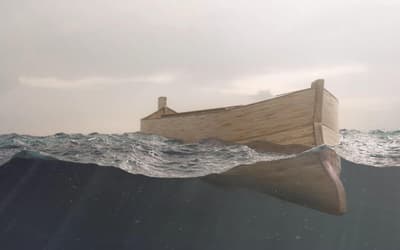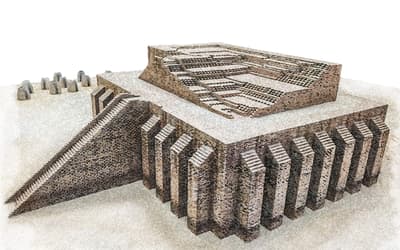The views expressed in this paper are those of the writer(s) and are not necessarily those of the ARJ Editor or Answers in Genesis.
Abstract
Habermehl (2011) in her paper “Where in the World is the Tower of Babel?” presented an alternate view of the ancient world after the Flood, wherein she places Babel, Shinar, and the other cities mentioned in Genesis, not in lower Iraq as held by the majority of Middle Eastern archaeologists, but in northern Syria. It will be my contention that her arguments for her view—southern Mesopotamia still being under water, and alternatives for the names of Shinar and Babel—do not stand up to critical examination, and should be discounted.
Keywords: Sumer, Shinar, Sinjar, Babel, Babylon
Introduction
Habermehl (2011) presented a paper entitled “Where in The World is the Tower of Babel.”
In that paper she concluded, against the claims of over 150 years of archaeological excavation, that the archaeological world had got the location of biblical Shinar wrong, and that Babel was to be located instead in northern Syria in the Khabur Triangle.
She, of course, has not been alone in this type of claim, as it is not new. In a private recent communication with Habermehl I was assured: “Shinar is not Sumer, as I prove in my paper” (emphasis mine). In further communication I pointed out that the idea of “proof,” while it may be applicable to experimental science, does not sit comfortably with history; such is from reasoned conclusions, and is not subject to “proof” as every criminal judge is painfully aware.
However, my point appears to have fallen on deaf ears. So let us look at Habermehl’s (2011) paper, and in doing so I will be succinct and not laboriously attempt to deal with every point.
Under Water?
One of the reasons that Habermehl (2011) does not accept Sumer is her assertion that certain unnamed authors have claimed that that area of the Middle East was under water at the time of Babel. There are several problems here. Firstly, what date does she put on Babel? The Bible is clear that it was at least a century after the Flood of Noah, in the time of Peleg, and the time period allotted to this can be no further back than 2500 B.C. (that is. if we add in the extra assumed 200 years claimed for the Israelite sojourn in Egypt). In giving this date I am claiming the figures of the Masoretic text, not the Septuagint (of which there are two versions).
Now Habermehl (2011) then claims the area was under water, a statement I cannot find backed up by any geologist, and all the ancient maps concerning the flooding of the Persian Gulf that I can access fail to show any such event. The highest rise known (other than Noah’s Flood) was up to the Quays of the very southern city of Ur as well as Eridu, as witnessed in the Sargonic annals. And Woolley’s excavation at Ur showed evidence of a “flood” that almost certainly was oceanic, and this followed in the late Uruk period after earlier habitation of the same culture.
A claim that in the time of Babel, Sumer was under water at the time of Babel rests on a theory, and no scientific evidence!
Shinar = Sinjar?
Secondly, then Habermehl (2011) discusses the name “Shinar” and seems to conclude that it is likely related to “Sinjar” up in the Khabur region. Sinjar is a name derived by the Aramaic people, and although in English such may be impressive, it is totally unrelated historically to “Shinar,” despite the claims made.
Shinar was given to us by Moses, the Egyptian-trained author/editor of the Torah. It comes not from Aramaic but from the Hebrew transliteration of the Egyptian word for Sumer = Senaar (in English).
Why would the Egyptians be familiar with southern Iraq = Sumer? Because during their early period, they received an influx by sea, and as David Rohl (1998) has shown, as an invasion from southern Iraq (Sumer) corresponding to the Late Uruk/Susiana (Elam) period and in Egypt to the Gerzean period. This then powerfully influenced their culture, starting in Upper Egypt, and moving inexorably to the Dynastic period of Egypt. Egypt was well aware of Sumer and called it Senaar.
The influx was almost certainly from another Egyptian tribe taking a different route and later, the Pathrusim of Genesis 10:13. Upper Egypt now became Pathros, and the Elite conquerors were called the Iry Pat, that is, “the people of Pat” (Pathrusim), the worshippers of the falcon god Horus.
We can thus conclude that the Egyptian “Senaar” = Hebrew “Shinar” = “Sumer” of Southern Iraq and bears no historical relation to Sinjar despite the linguistic similarities.
The Name Babel
Habermehl (2011) spends considerable time on the name Babel.
Let us be clear the Bible itself tells us that the name Babel indicates “confusion” Genesis 11:9, as Strong’s (1995) concordance also makes clear, and Gesenius (1979) indicates, comes from a root that can indicate stammering. Moreover, it is the same word as “Babylon” despite Habermehl’s contrary claim.
Then Habermehl (2011) discusses the statement in Daniel 1:1–2, where we are told that the King of Babylon, took the vessels of the house of God and placed them into the temple of his god in the land of Shinar, and then by complicated reasoning decides that this means that he first put them in a temple in the north before going on to Babylon.
This type of reasoning violates the simple, straightforward narrative and places Habermehl’s own assumptions, not at all borne out by the narrative, to back up her own presuppositions. This is pure imagination.
Following that, Habermehl (2011) attempts to identify the cities, known from the archaeological record to be in southern Iraq, and uses vague arguments to back her non-conclusive identifications. She also claims that Shinar indicates a place between “two rivers,” and ignores the fact that Sumer lies between the two great rivers of Mesopotamia, the Tigris and Euphrates, which is also the meaning of the Greek name “Mesopotamia.” Instead, she suggests that it refers to some other minor rivers in the Khabur region.
There are considerably more discussions that could be marshalled against the conclusions of her paper, but tedium would set in by outlining them. In short, despite her bold assertions, Habermehl (2011) has not established the case, and has certainly not “proved” that Shinar lies other than in southern Iraq.
Conclusion
From a multitude of evidence established over the last 150 years of intensive excavation and translation of thousands of cuneiform tablets and documents, Shinar = Sumer in southern Iraq. And the archaeological site “Warka” is Uruk and is the same as biblical “Erech” since vowel changes in semitic language translation are fluid. Ur is Ur of the Chaldees, excavated by Leonard Woolley, and much evidence in the archaeological record identifies that region as Chaldean. While Babel may not have been on the exact site of later Babylon, there is clear historical and legendary connection to identify the Babel structure in Sumer somewhere close to the later Babylon.
References
Gesenius, H. W. F. 1979. Gesenius’ Hebrew and Chaldee Lexicon to the Old Testament. Translated by Samuel Prideaux Tregelles. Grand Rapids, Michigan: Baker Book House
Habermehl, Anne. 2011. “Where in the World is the Tower of Babel?” Answers Research Journal 4 (March 23): 25–53. https://answersresearchjournal.org/where-is-the-tower-of-babel/.
Strong, James. 1995. The New Strong’s Exhaustive Concordance of the Bible. Nahsville, Tennessee: Thomas Nelson Publishers.
Rohl, David. 1998. Legend: The Genesis of Civilization. London, United Kingdom: Century Publications.








